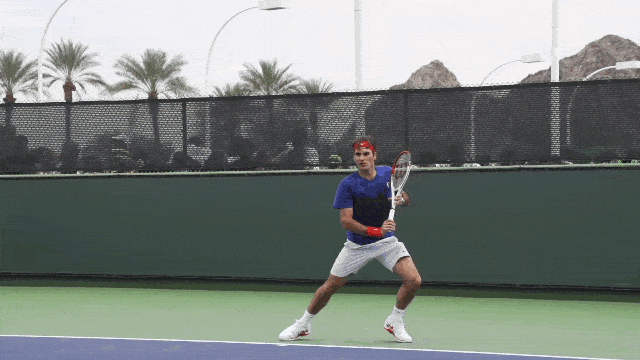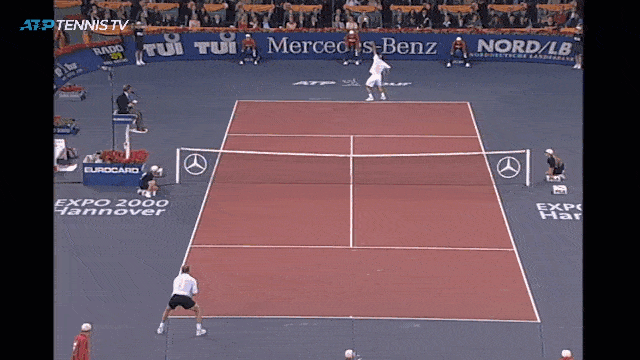The Shots of Tennis
A Comprehensive Visual Guide of Every Shot in Tennis
Every shot archetype, apart from the serve, has a forehand and backhand equivalent. Forehand and backhand merely describe the usage of the dominant or non-dominant side. For righties, the forehand will be struck on the right side while the backhand is on the left - the inverse for lefties. The specific shot itself will determines how many hands are used.
WARNING: This is a GIF-HEAVY section.
please allow some time to load
INDEX
Ground Strokes
Forehand
Reverse-Forehand
Two-hand Forehand
Backhand
One-Handed Backhand
Two-Handed Backhand
Air Ground Strokes
Slice
Forehand
Backhand
Volleys
Forehand
Backhand
Half-Volley
Overheads
Forehand
Backhand
“Skyhook”
Serve
Standard
Drop shot
Return
Forehand
Backhand
SABR
Tweeners
Ground Strokes
The bread and butter of tennis. As the name suggests, this involves striking the ball after one bounce on the ground. All ground strokes are hit with a low to high motion, imparting natural topspin on the ball. This creates air pressure on the top of the ball, pushing the ball downwards into the court. Thus, top spin prevents balls that normally would go out, which overall, gives the ground stroke a natural level of consistency.
Forehand
modern forehand
Novak Djokovic’s Forehand.
The Modern forehand is a topic on it’s own, but we can see many elements present in Novak’s shot.
Quick take-back, accentuating the unit turn
Extended swing powered mainly through the hip and trunk rotation, followed by wind-shield wiper finish
Semi Open stance allowing him to bring his weight into the court while simultaneously generating rotational force
reverse forehand
“Buggy Whip” or “Banana” Forehand
Rafael Nadal’s signature “buggy-whip” forehand
It has many names, but the distinctive trait of the reverse forehand is a finish over the head, instead of the opposite shoulder. The reverse-forehand is an adaption to balls in which you do not have time to swing fully. It produces extra top-spin in addition to having extra flexibility in its contact point. This utility is vital for when you are on the dead run and/or the ball is coming extremely fast.
two-handed forehand
Monica Seles’s two-handed
The two-handed forehand originates most likely as an adaptation to a general muscle-weakness in young junior players. Once the muscle memory sets in, it’s tough for players to switch to a standard forehand. For the most part, there’s not much of a place for this in the modern tour. As a coach, it can be hard to recommend this to anyone, but if your heart is set on it, you can make it work. Players with a two-handed forehands win through smart placement, and tricky point construction. Notable players include Monica Seles, Fabrice Santoro, and Su-wei Hsieh.
Backhand
one-handed backhand
Roger Federer’s One handed backhand. Many see it as work of art. Others call it his kryptonite. In many regards, he has taken the classical one hand technique to it’s absolute limits. Although it has very defined weaknesses, the offensive capabilities of his one hander in combination with his slice is a big reason for his success.
Revered as the most beautiful shot in tennis, the one-hand backhand emits a certain level of grace and exuberance. Yet, from a practical standpoint, it is often plagued with a steep learning curve, and a general difficulty in maintaining heavy ground-stroke rallies. Therefore juniors are often recommended to play two-handed. For some time, the one-hander was even predicted to fall extinct. Yet strangely enough, the one-hand has resurged and became a staple in the top 10. The new generation of talent in addition to the old-guard have managed to make revolutions and adaptions to the classic shot.
two-handed backhand
The two-hander was once the newcomer in a world of one hand backhands. A half century later, how the tables have turned. Whereas the reach is more restricted, the extra hand and closer range gives an edge in stability and consistency. A subtle mechanical detail is that the two-hand most intuitively takes advantage of the rotational aspect of power predominant in today's modern tennis.
Novak Djokovic’s backhand - Often touted as the best this sport has ever seen. Although it isn’t very flashy, his backhand’s versatility in offense and defense has no peer.
Air Ground Strokes
Usually, ground strokes are quite… grounded. If you need elevation, it is far more efficient to jump with the ball. The legs will still be involved and you are hitting the ball on the way up. On the other hand, these jumping ground strokes are hit on the way down. So you are literally hitting the shot while falling in the air. You lose almost all the lower body in the kinetic chain, but will have access to the top of ball, in which you can hit down into the court. There’s an air of showboating involved and slight impracticality, but hey… worth it, right?
air one-hander
The one hander, has great reach laterally but not so much for height because of the way the shoulder mechanics work. For classical one handers this shot doesn’t work because of how reliant it is on the legs. The modern one-handers are more rotational based, and allows these shots to work in addition to being far more powerful and heavy.
air forehand
The forehand has the most flexibility in it’s contact range, so there’s really no reason to do this for most players. That being said, this shot makes sense, because Kyrgios’ forehand naturally relies more on internal shoulder rotation and doesn’t loose too much from the loss of his legs.
Slice
The slice is the yin to the yang of the ground stroke. Opposite to ground strokes, the slice uses a high to low motion with a continental grip to produce backspin. This spin puts air pressure below the ball, lifting it in the air, taking longer to travel across the net, and bouncing less forward once they reach the opposite court. As a defensive shot this is invaluable, as the extra time and flexibility of the shot allows you to hit it from almost any position.
forehand slice
Kim Clisters's demonstrates a forehand slice in a commercial. Though it’s a simulated shot, the technique demonstrated is still superb.
backhand slice
Roger Federer’s slice is heralded as the best in the game.
Volley
As opposed to ground strokes which are hit after the bounce, the volley is struck in the air, before it hits the ground. In terms of mechanics, the volley is like a distant cousin of the slice. The high to low motion is similar, but there are key differences. At the net, you have less time to react and more force coming at you. Therefore, the volley is designed to be short and crisp, reflecting the force coming at you, while taking advantage of the greater range of angles available to you. In addition, while you will inevitably hit high to low, the focal point should be driving through the ball.
forehand volley
backhand volley
Overhead
Overheads as the name suggests, is hit above the player’s head with a serve-like motion. A player will often be positioned near the front court to hit the overhead which in combination with it’s power, usually results with the end of a point.
overhead smash
The standard overhead smash always refers to the forehand side. Due to easy power and range of the dominant side, players are often recommended to always take the smash on the forehand side if possible.
US Open 2019 QF: Roger Federer his a perfectly angled smash against Grigor Dimitrov.
backhand overhead smash
slam dunk
sky hook
Rafa Nadal’s sky-hook is the best in the business.
The sky-hook is hit behind you, and thus relies more on an abreviated motion and finish. To compensate for poor positioning, players will often need to use an eastern grip to get more “omph” on the ball.
Serve
Pete Sampras possesses one of the most intricate and potent serve in history.
under-arm serve
Despite the controversy, the shot itself is an extremely smart tactic. Nadal stands extremely far back which is a smart ploy to counter pace and force servers to go for placement and not speed. Just as a drop shot punishes baseliners for standing too far back, this shot punishes Nadal for his return position. Coupled with Kyrgios impressive serving, the under-arm serve has a natural synergy with his game.
Return
The return is second place in terms of value in tennis. One might think that the return is essentially the same as a normal ground stroke, but this is a mistake. The speed and force that one must return requires specific adaptation to your normal ground strokes. Therefore, returns tend to be simpler and drive through the ball to counter the pace.
forehand return
backhand return
sabr: sneak attack by roger
Federer made waves in both the tennis community and tour when he pulled this out in the 2015 summer hard court swing.
This little innovation from Federer, cuts off the reaction time off the server, which pressures the server often forcing an error from the server. From there he can take advantage from the net. This winner from Federer is best case scenario from brilliant execution.
Tweener
The holy grail of trick shots. Yet, surprisingly there is practical value in tweeners. That is unless your name is Nick Kyrgios.
off the lob tweener
Hitting the Tweener off the lob is the most practical application. Because you are hitting the ball in between your legs,you can run straight at the ball as opposed to coming at it an angle, which can save you valuable time.
facing the net tweener
For Kyrgios, the tweener is done on a whim with no rhyme or reason. Sometimes it can end spectacularly.
From a practical stand point, this shot is useful when you slightly overrun the ball, and it comes directly at you.






















